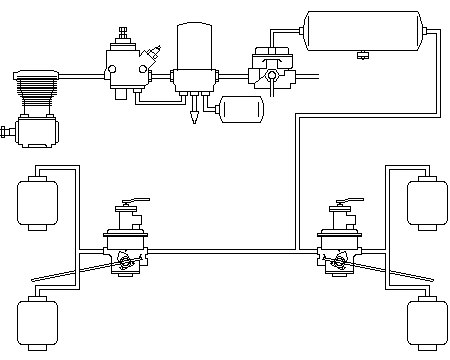|
|
Air Suspension
| The weight determines the bellows-pressure.. |
| Special features |
| Level regulation inclusive |
| Progressive characteristic curve |
| Additional wheel suspension needed |
| Almost no self-damping |
Function
The air suspension combines a particularly sensitive suspension response with the advantages of a pre-selectable and/or automatically regulated pre-tensioning of the springs. Thus, the laoding surface height can be
influenced in trucks or the level-height in coaches, as well as the behaviour of vehicles in curves or on uneven roads and/or makes light-beam range regulation unnecessary. However, should the level also stay constant
with heavy loading, the suspension must be made harder.

How it works
In trucks and coaches, (see above diagram) this spares the already available compressed-air equipment. In this case, air-filled bellows (see above picture) replace the steel springs completely. However, with the
omission of leaf-springs an expensive wheel suspension or axle mounting is necessary. Depending on the complexity, the assembly can be regulated, as a
whole, or unilaterally, as well as
the behaviour in critical driving situations and also the shock absorbing. Progressive springing is a characteristic of air suspension anyhow. The rolling angle in curves is considerably reduced. The disadvantage is the construction cost, which it makes the production expensive and the selling price high. In the motor car, additional pressure
production, water drainage and storage is necessary.
In utility vehicles, more often than not, the vehicle-height must be re-determined. In addition, the question, of whether a vehicle actually has its tare-weight, is overdue. This should be higher with the refuse truck than with
the tractor-trailer truck. If one considers the, up to 1.500-2.000 liters of fuel volume (incl. additional tanks), the question is not quite as simple to answer as in the case of the motor car.
In any event, the vehicle comes into the garage in a certain weight condition and then must be re-adjusted to the standard height. After the disconnection of all the specific features, for example, the raised driving position,
one raises the vehicle using the lift control in the driver's cab and brings the required spacings into place. If these are not excessively squeezed when lowering, one can settle on this measure. The maximum value
develops from pressure measurement when raising, because at the maximum point, the bellows pressure suddenly rises faster. This would then be the uppermost point of the suspension. Care is to be taken that a
spring movement of 40-60 mm still remains. In addition, the steering is to be considered. If its push rod now has a different incline, the center position of the steering gear no longer concurs with the straight running
position. 10/09
|
|